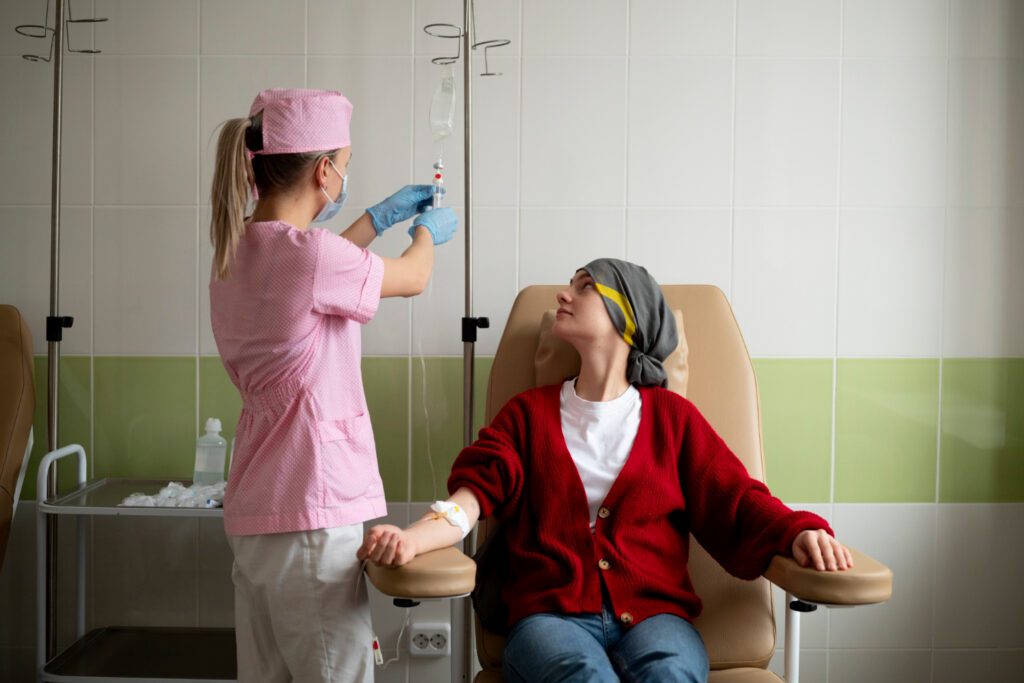Chemotherapy for Breast Cancer uses powerful drugs to target and kill cancer cells. Unlike localized treatments like surgery or radiation, chemotherapy works throughout the body, making it particularly effective for cancers that have spread or have the potential to spread.
Key Takeaways:
- Chemotherapy is a vital tool in treating breast cancer, especially when cancer has spread.
- Personalized treatment plans maximize the effectiveness of chemotherapy.
- Managing side effects is crucial for maintaining quality of life during chemotherapy.
- Advances in chemotherapy are making treatments more effective and tolerable.
- Seeking a second opinion can provide reassurance and potentially better treatment options.
How Chemotherapy Works Against Breast Cancer
Chemotherapy drugs attack rapidly dividing cells, a hallmark of cancer. By disrupting cell division, chemotherapy can shrink tumors, slow their growth, and even eliminate cancer cells. This systemic approach is crucial in treating breast cancer, especially in advanced stages where the cancer may have spread beyond the breast and nearby lymph nodes.
Types of Chemotherapy Drugs
There are various chemotherapy drugs used to treat breast cancer, each with a unique mechanism of action. Common drugs include:
- Anthracyclines (e.g., Doxorubicin): These interfere with DNA replication.
- Taxanes (e.g., Paclitaxel): These stabilize cell structures, preventing division.
- Alkylating Agents (e.g., Cyclophosphamide): These damage DNA, inhibiting cancer cell growth.
Choosing the right combination of these drugs depends on the cancer’s specifics and the patient’s health.
Benefits and Risks of Chemotherapy
1. Advantages of Chemotherapy
Chemotherapy for breast cancer offers several benefits:
- Systemic Treatment: Effective against cancer cells that have spread.
- Tumor Reduction: Shrinks tumors, making surgery more feasible.
- Adjuvant Therapy: Reduces the risk of cancer recurrence after surgery.
2. Potential Side Effects
While effective, chemotherapy is not without risks. Common side effects include:
- Fatigue
- Nausea and vomiting
- Hair loss
- Increased risk of infection
It’s essential to weigh these side effects against the benefits and manage them effectively during treatment.
3. Long-Term Impacts
Long-term effects of chemotherapy can include:
- Cognitive Changes: Sometimes referred to as “chemo brain.”
- Heart Health: Certain drugs can affect heart function.
- Fertility Issues: Chemotherapy can impact reproductive health.
Understanding these risks helps patients make informed decisions about their treatment.
The Chemotherapy Treatment Process
1. Preparing for Chemotherapy
Preparation involves several steps to ensure the body can handle the treatment:
- Medical Tests: Blood tests, imaging, and heart function tests.
- Nutritional Support: Eating a balanced diet to maintain strength.
- Emotional Readiness: Counselling and support groups can be beneficial.
2. During the Treatment
Chemotherapy is typically administered in cycles, with each cycle followed by a rest period to allow the body to recover. Treatment can be given:
- Intravenously (IV)
- Orally (Pills)
- Injection (Shot)
The environment is usually supportive, with medical professionals monitoring for adverse reactions.
3. Post-Treatment Care
After chemotherapy, patients need comprehensive care:
- Regular Follow-Ups: Monitoring for recurrence or new side effects.
- Rehabilitation: Physical and occupational therapy if needed.
- Psychosocial Support: Continued counselling to address emotional well-being.
Personalized Chemotherapy Plans
1. Tailoring Treatment to Individual Patients
No two breast cancer cases are identical, which is why personalized chemotherapy plans are crucial. These plans are tailored based on:
- Cancer Type and Stage: Specific characteristics of the tumor.
- Genetic Factors: Genetic mutations can influence drug choice.
- Patient Health: Overall health, age, and comorbidities.
Personalized plans aim to maximize effectiveness while minimizing side effects.
2. Factors Influencing Chemotherapy Plans
Several factors influence how chemotherapy is tailored:


- Hormone Receptor Status: Estrogen and progesterone receptor status.
- HER2 Status: Presence of the HER2 protein on cancer cells.
- Patient Preferences: Personal choices regarding treatment intensity and side effects.
These factors help oncologists design a treatment plan that best suits the patient’s unique needs.
Did You Know?
Women with HER2-positive breast cancer have seen improved outcomes with targeted therapies combined with chemotherapy.
Managing Side Effects
1. Common Side Effects and Management Strategies
Managing side effects is vital for maintaining quality of life during chemotherapy. Common side effects include:
- Fatigue: Rest and light exercise can help manage energy levels.
- Nausea and Vomiting: Anti-nausea medications can be effective.
- Hair Loss: Scalp cooling caps might reduce hair loss.
- Infection Risk: Good hygiene and avoiding crowds can lower infection risk.
2. Supportive Care During Chemotherapy
Supportive care enhances the treatment experience:
- Nutritional Support: Dietitians can recommend foods that help maintain strength.
- Pain Management: Medications and therapies to manage pain.
- Emotional Support: Counseling and support groups provide mental and emotional relief.
Advances in Chemotherapy for Breast Cancer
1. Recent Research and Innovations
The field of chemotherapy is continuously evolving. Recent advancements include:
- Immunotherapy Combinations: Enhancing the immune system’s ability to fight cancer.
- Targeted Drug Delivery: Reducing side effects by directly targeting cancer cells.
- Genomic Testing: Identifying the most effective drugs based on genetic profiles.
These innovations are making chemotherapy more effective and tolerable.
2. Emerging Treatments
New treatments are on the horizon:
- PARP Inhibitors: Particularly effective for BRCA-mutated cancers.
- ADC (Antibody-Drug Conjugates): Delivering chemotherapy directly to cancer cells.
- Nanotechnology: Enhancing drug delivery and reducing side effects.
Emerging treatments offer hope for even better outcomes in the future.
3. Future Directions
The future of chemotherapy for breast cancer looks promising:
- Personalized Medicine: More precise treatments based on individual genetic profiles.
- Combination Therapies: Using multiple drugs to target cancer more effectively.
- Less Toxic Treatments: Finding ways to minimize side effects while maintaining efficacy.
Importance of a Second Opinion
1. Why Get a Second Opinion?
Seeking a second opinion can provide valuable insights:
- Confirmation of Diagnosis: Ensures the initial diagnosis is accurate.
- Treatment Options: May reveal alternative treatment plans.
- Peace of Mind: Provides reassurance and confidence in your treatment plan.
Second opinions are especially important in complex cases like breast cancer, where treatment decisions can significantly impact outcomes.
2. How Cancer Care Nexus Can Help
Cancer Care Nexus offers comprehensive second opinion services:
- Expert Oncologists: Access to top specialists in breast cancer treatment.
- Thorough Review: Detailed analysis of medical records and diagnostic tests.
- Personalized Recommendations: Tailored treatment plans based on the latest research.
Conclusion
Navigating chemotherapy for breast cancer can be daunting, but understanding the treatment process, managing side effects, and knowing the latest advances can make a significant difference. Personalized treatment plans ensure the best possible care tailored to individual needs, and seeking a second opinion can provide reassurance and potentially reveal new options. With the right support and information, patients can approach their treatment with confidence and hope for a positive outcome. For those looking to explore their treatment options further, Cancer Care Nexus is here to help every step of the way.



